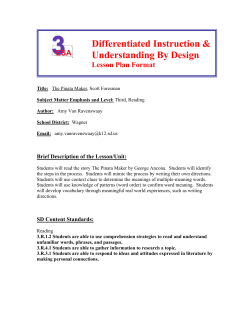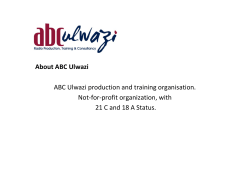
Description of Water Quality and Shellfish Tissue Sample Database
Description of Water Quality and Shellfish Tissue Sample Database Transport and Fate of Nutrient and Pathogen Loadings into Nearshore Puget Sound EPA Grant DW-13-923276-01 (Database online at the Puget Sound Institute, Encyclopedia of Puget Sound: http://www.eopugetsound.org/articles/database-transport-and-fate-nutrient-and-pathogen-loadingsnearshore-puget-sound) This document describes an Access database that contains existing data on water quality concentrations of nutrients, pathogens, and physical marine characteristics, and shellfish tissue sample analyses for the three Puget Sound sites chosen for this study (Hamma Hamma, Dosewallips, Samish). Project Overview The Puget Sound estuary provides one of the most valuable shellfish habitats in the Pacific Northwest. Shellfish are commercially, recreationally and culturally important resources in our region, and their prominence in near-term priority actions in the Puget Sound Partnership (PSP) Action Agenda reflects their high value among a diversity of stakeholders. Ecologically, they are affected by the composition of freshwater entering the nearshore marine system and internal marine dynamics. Shellfish bed closures area-wide have decreased, but in certain locations, persistent closures continue, affecting local growers and restricting commercial and recreational harvest opportunities. Shellfish growing area closures are considered to be a result of several factors that include growing areas exposed to excess nutrient and pathogen concentrations, with their effects complicated by non-point source nitrogen pollution (i.e., failing septic systems, agricultural wastewater, and stormwater). Declining water quality is associated with changes in the composition of watersheds and nearshore habitats from primarily forested to landscapes dominated by agricultural, rural residential and urban land uses. In addition, future changes in climate will add another layer of complexity and increase potential threats to ecosystems that support shellfish through impacts on freshwater flows, marine circulation, and water temperature. A PSP priority is to reduce the risks of shellfish growing area closures and adverse effects on human health. Information that can predict pathogen concentrations along transport pathways where they pose a risk to shellfish and human health will help in achieving this goal. With funding from the EPA (EPA Interagency Agreement DW-13-923276-01), scientists at the Northwest Fisheries Science Center and the University of Washington used a field and quantitative modeling ‘source-transport-fate’ assessment approach to classify the vulnerability of shellfish growing areas to closures caused by watershed and marine-derived pathogens. Based on the historical prevalence of nutrient pollution, shellfish closures, and phytoplankton blooms in commercial and recreational shellfish growing area, the project focused on three nearshore sites-the Hamma Hamma (WRIA 16), Dosewallips (WRIA 16) and Samish (WRIA 3) (Figure 1). These nearshore areas are downstream from similarly-sized watersheds characterized by different land-use types (e.g., different cover of forested and agricultural lands), and they each have certified commercial and recreational shellfish beds. The Hamma Hamma (217 km2) and Dosewallips watersheds (298 km2) are mostly forested basins and are located in the western Hood Canal Basin. The Samish watershed (299 km2) is predominantly rural with agricultural runoff as the dominant N-source inputs to the sound (WA DOH, Lawrence Sullivan personal communication). Secondary Data Collection As part of this project, we have collected existing data on water quality concentrations of nutrients, pathogens, and physical marine characteristics, and on shellfish tissue sample pathogen analysis for the three Puget Sound study sites and have compiled them into a database. We collected all available data on water quality within the spatial limitations for these watersheds that span the period 1910 to present; we have shellfish tissue sample analysis for shellfish growing areas in the three study site areas and a limited number of years, which will be updated and posted to the online database1. The data collected are organized and stored in a MS Access 2010 database. Data are organized into tables with built-in relationships between common fields. Front end users can specify desired subsets of water quality data records through the use of queries. Because secondary data was collected from a variety of sources, QA/QC standards varied substantially. We did not restrict our data acquisition based on QA/QC. We included a table “Data_Sources”, containing records with links back to original documents and descriptions of the level of QA/QC documentation. The primary sources for water quality and stream flow data were the Washington State Department of Ecology, the Washington State Department of Health, and the United States Geological Survey (USGS); we also collected data from Port Gamble S’Klallam Tribe, Skagit River Cooperative Storm Team, Hood Canal Dissolved Oxygen Program and Aspect Consulting Inc. to fill spatial and temporal data gaps. 1 The database can be accessed online at the Puget Sound Institute, Encyclopedia of Puget Sound: http://www.eopugetsound.org/articles/database-transport-and-fate-nutrient-and-pathogen-loadings-nearshore-pugetsound. 2 General sources for secondary data acquisition WA Department of Ecology (DOE) data from long-term and basin2 stations: Timeframe: varies by station; some date back to 1950’s Frequency: monthly; continuous temperature and flow data at certain stations Availability: downloadable; data for entire WRIA can be downloaded at once3 Variables measured: Varies over time; ~14 conventional water quality parameters4 WA Department of Health shellfish tissue sample analysis5: Timeframe: 2010 – 2013 (to be updated) Frequency: intermittent Availability: Data are available from the WA Department of Health Variables measured: Concentrations of paralytic shellfish poison (PSP), domoic acid, and diarrhetic shellfish poisoning (DSP) toxins USGS NWIS database for Washington State: Timeframe: varies by station Frequency: daily Availability: downloadable Variables measured: Stream flow and gage height only 2 Stations sampled since 2003 for one year only, sometimes every five years. 3 See the link at the bottom of the page. 4 Cond., FC, flow, NH3-N, NO2+NO3-N, SRP, O2, pH, pressure, SS, temp., total P, total persulfate N, turbidity 5 The WA Department of Health conducts shellfish tissue sample analysis using protocols identified in U.S. Food and Drug Administration, 2011, National Shellfish Sanitation Program (NSSP), Guide for the Control of Molluscan Shellfish, 2011 Revision. Washington, D.C. 3 Data sources for individual study sites 1. Samish - Empirical Water Quality Data Sources (Figure 2) 1.1. DOE “basin” stations: 1.1.1. 03B045 - Samish R. nr Mouth 1.1.1.1. Sampled 1x/month in 1995, 2000 1.1.2. 03B070 – Samish River nr Hoogdal 1.1.2.1. Sampled 2x/month in 1971 1.1.3. 03B075 - Samish R. @ German Prairie 1.1.3.1. Flows measured from Feb 2006 - Oct 2007 1.1.4. 03B077 - Samish R abv Parsons Cr 1.1.4.1. Sampled 1x/month in 2010 1.1.5. 03B080 - Samish R. nr Prairie 1.1.5.1. Sampled 1x/month in 1995 1.1.6. 03C060 - Friday Cr Blw Hatchery 1.1.6.1. Sampled 1x or 2x/month in 1974, 1993, 1995 1.1.6.2. Flows measured continuously May 2005 – Temperature 1.1.7. 03C080 - Friday Cr at Alger 1.1.7.1. Sampled 2x/month in 1974 1.1.8. 03K070 – Silver Cr nr Alger 1.1.8.1. Flows measured continuously March 2005 – Temperature 1.2. DOE “long-term” station: 1.2.1. 03B050 - Samish R nr Burlington 1.2.1.1. Sampled 1x or 2x/month since 1959 (most years) 1.2.1.2. Continuous temp data 2001-2008 1.2.1.3. Flows measured from Oct 1996 - Sept 2002 1.3. USGS stations: 1.3.1. 12201500 - SAMISH RIVER NEAR BURLINGTON, WA 1.3.1.1. Flow from 1943 to present; gage height 2001 to present 1.3.2. 12201000 - FRIDAY CREEK NEAR BURLINGTON, WA 1.3.2.1. Flow from 1943 to 1948 1.4. EIM stations: 1.4.1. Many sampling stations from various studies 2. Dosewallips - Empirical Water Quality Data Sources (Figure 3) 2.1. DOE “basin” stations: 2.1.1. 16D070 - Dosewallips R @ Brinnon 2.1.1.1. Sampled sporadically to monthly; 1959-1974, and 1994 2.1.1.2. Flows measured continuously March 2007 – Present 4 2.1.1.3. Continuous water temperature also? 2.2. USGS stations: 2.2.1. 12053000 - DOSEWALLIPS RIVER NEAR BRINNON, WA 2.2.1.1. Flow from 1930 to 1951 2.2.2. 12053500 - DOSEWALLIPS RIVER AT BRINNON, WA 2.2.2.1. Flow from 1910 to 1930 2.3. Port Gamble S’Klallam Tribe data: 2.3.1. Stream temperature gages covering summers of 2001 and 2002 2.3.1.1. Dosewallips-Lower: at Dosewallips State Park RM 0.5 2.3.1.2. Dosewallips-Upper: near 6 Mile Bridge (~RM 5.5) 2.3.1.3. Rocky Brook Crk: ~100 feet upstream of confluence with Dosewallips 2.3.1.4. See PGST Dose-Duck water temp data.xls in PS_SHIRAZ\Temperature_data 3. Hamma Hamma - Empirical Water Quality Data Sources (Figure 4) 3.1. DOE “basin” stations: 3.1.1. 16B070 - Hamma Hamma R nr Mouth 3.1.1.1. Sampled sporadically; 1962-1972 (most years) 3.1.1.2. Various parameters 3.1.2. 16B110 - Hamma Hamma R nr Eldon 3.1.2.1. Sampled sporadically to monthly; 1973, 1974, 1994 3.1.2.2. Various parameters 3.2. USGS stations: 3.2.1. 12054500 - HAMMA HAMMA RIVER NEAR ELDON, WA 3.2.1.1. Flow from 1951 to 1971 3.2.2. 12055000 http://waterdata.usgs.gov/wa/nwis/dv/?site_no=12055000&referred_module=q wHAMMA HAMMA RIVER NEAR HOODSPORT, WA 3.2.2.1. Flow from 1926 to 1930 3.2.3. 12054600 http://waterdata.usgs.gov/wa/nwis/dv/?site_no=12054600&referred_module=q wJEFFERSON CREEK NEAR ELDON, WA 3.2.3.1. Flow from 1957 to 1971 3.3. EIM data: 3.3.1. Site name = JOHN CREEK NEAR HWY 101 3.3.1.1. Flow measured once in 1986 3.3.2. Site names = C-01, C-03, C-04 3.3.2.1. FC measured once in 2005 3.3.2.2. Appears to have been measured in nearshore marine waters, not FW 5 3.4. Aspect Consulting data: 3.4.1. One gage on Hamma Hamma mainstem 3.4.2. Measured stream temperature and flow from 2004-2005 3.4.3. See Hamma_Discharge.xls in PS_SHIRAZ\Flow_data 3.5. Port Gamble S’Klallam Tribe data: 3.5.1. 2 stream temperature gages covering 2002-2003 year-round 3.5.1.1. Hamma Hamma mainstem, ~200 feet upstream of Johns Cr confluence 3.5.1.2. Johns Creek, ~50 feet upstream of confluence with Hamma Hamma 3.5.1.3. See PGST HamaHamma water temp data.xls in PS_SHIRAZ\Temperature_data 6 S1 Jua an de Fuca Stra ait D2 2 Seattle H3 oposed study y shellfish grrowing areass, which are labeled S1 (Samish), D22 Figure 1:: Map of pro (Dosewaallips) and H3 (Hamma Hamma). H 7 Figure 2. 2 The Samish Basin (ligh ht brown) with w water quuality sampliing stations ffrom variouss sources plotted: p yello ow points aree EIM statio ons; green pooints are DO OE stations; ppink points aare USGS staations. The river channeel (blue line)) and ShoreZ Zone shoreliine (purple liine) are also shown, as a are the Sam mish and non n-Samish GS SUs (light blue and lightt gray polyggons, respectiv vely). wallips Basin n (light brow wn) with watter quality saampling statiions from Figure 3. The Dosew various sources s plotted: yellow points p are EIM stations; ggreen pointss are DOE sttations; pinkk points aree USGS stattions. The riiver channel (blue line) aand ShoreZoone shorelinee (purple linne) are also shown, s as arre the Dosew wallips and nonn Dosewaallips GSUs ((light blue aand light grayy polygonss, respectivelly). Figure 4. 4 The Hamm ma Hamma Basin B (light brown) b with water qualitty sampling stations from m various sources s plotted: yellow points p are EIM stations; ggreen pointss are DOE sttations; pinkk points aree USGS stattions. The riiver channel (blue line) aand Shore Z Zone shorelinne (purple linne) are also shown, s as arre the Hamm ma Hamma an nd non- Ham mma Hammaa GSUs (lighht blue and llight gray poly ygons, respectively).
© Copyright 2025










